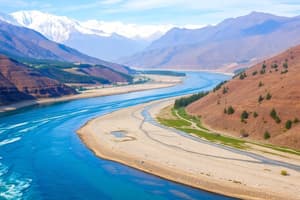Podcast
Questions and Answers
Which of the following rivers is NOT a tributary of the Indus River?
Which of the following rivers is NOT a tributary of the Indus River?
- Shyok
- Hunza
- Zaskar
- Alaknanda (correct)
What percentage of the Indus river system's water can India legally use according to the Indus Water Treaty?
What percentage of the Indus river system's water can India legally use according to the Indus Water Treaty?
- 20% (correct)
- 50%
- 40%
- 30%
Which river system has its headwaters at the Gangotri Glacier?
Which river system has its headwaters at the Gangotri Glacier?
- Indus
- Brahmaputra
- Jhelum
- Ganga (correct)
Where does the Indus River emerge from the mountains?
Where does the Indus River emerge from the mountains?
Which of the following rivers joins the Indus near Mithankot in Pakistan?
Which of the following rivers joins the Indus near Mithankot in Pakistan?
What is the approximate total length of the Indus River in kilometers?
What is the approximate total length of the Indus River in kilometers?
In which region do several tributaries, including the Zaskar and Nubra, join the Indus River?
In which region do several tributaries, including the Zaskar and Nubra, join the Indus River?
Which of the following statements is true regarding the flow of the Ganga?
Which of the following statements is true regarding the flow of the Ganga?
What geographic feature does the Indus River create as it flows through Ladakh?
What geographic feature does the Indus River create as it flows through Ladakh?
Flashcards are hidden until you start studying
Study Notes
Major Himalayan Rivers
- Significant rivers include the Indus, Ganga, and Brahmaputra, along with numerous important tributaries.
- A river and its tributaries collectively form a river system.
Indus River System
- Originates in Tibet near Lake Mansarovar and flows westward into India at Ladakh.
- Known for its scenic gorges and numerous tributaries including the Zaskar, Nubra, Shyok, and Hunza, located in the Kashmir region.
- Travels through Baltistan and Gilgit, exiting the mountains at Attock.
- Major tributaries (Satluj, Beas, Ravi, Chenab, and Jhelum) converge near Mithankot in Pakistan.
- Length of the Indus is approximately 2900 km, making it one of the longest rivers globally.
- Over one-third of the Indus basin is situated in India (Ladakh, Jammu and Kashmir, Himachal Pradesh, Punjab), with the remainder in Pakistan.
- The Indus Plain features a very gentle slope.
- Under the Indus Water Treaty (1960), India is permitted to utilize only 20% of the total water from the Indus river system, primarily for irrigation in Punjab, Haryana, and parts of Rajasthan.
Ganga River System
- The Ganga's source, the Bhagirathi, is fed by the Gangotri Glacier and merges with the Alaknanda at Devaprayag in Uttarakhand.
- At Haridwar, the Ganga transitions from mountainous terrain to plains, marking a significant geographic shift.
Studying That Suits You
Use AI to generate personalized quizzes and flashcards to suit your learning preferences.




